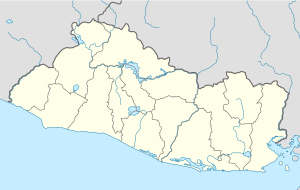Acajutla
|
Acajutla Acaxutla |
|
|---|---|
| Municipality | |
 |
|
| Location in El Salvador | |
| Coordinates: 13°35′24″N 89°50′01″W / 13.59000°N 89.83361°W | |
| Country |
|
| Department | Sonsonate Department |
| Area | |
| • Total | 166.59 km2 (64.32 sq mi) |
| Elevation | 24 m (79 ft) |
| Population (2012) | |
| • Total | 29,701 |
| • Density | 180/km2 (460/sq mi) |
Acajutla is a seaport and municipality in Sonsonate Department, El Salvador. The town is located at 13°35′24″N 89°50′01″W / 13.59000°N 89.83361°W on the Pacific Coast of Central America and is El Salvador's principal seaport from which a large portion of the nation's exports of coffee, sugar, and Balsam of Peru are shipped. As a municipality, Acajutla is one of seventeen such districts in Sonsonate. As of 1992, the population of the town was 18,008, and of the municipality 47,678.
Spanish conquistador Pedro de Alvarado, under the command of Hernán Cortés, had conquered Mexico and Guatemala before coming to the vicinity of Acajutla. There he met heavy resistance, but defeated the indigenous people in 1524 and conquered all of present-day El Salvador at the Battle of Acajutla.
Following the complete independence of El Salvador in 1838, the economy of the nation became increasinging dependent on the export of coffee. The rapid growth of this lucrative "cash crop" led to profound socio-economic changes in the region, and drew of the attention of foreign investors and the local plantation owners to Acajutla, where infrastructure development was seen as necessary to assure the transport of crops from the interior and the ability to load them efficiently aboard ships.
...
Wikipedia

